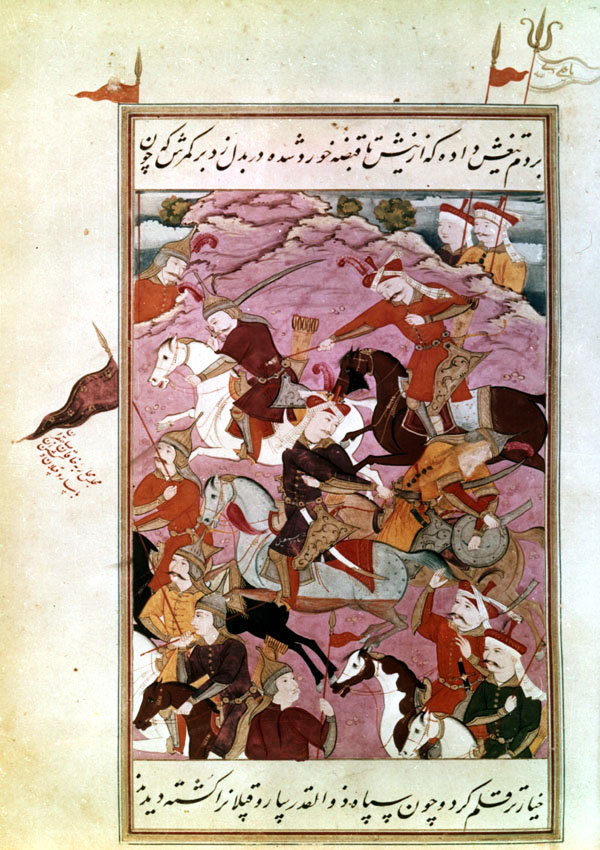Manuscripts
tāriḵ-e ʿālām-ārā-ye šāh esmāʿil
There are considerable differences between the event depicted in thispainting, the account of the same event in the text, and the testimony given by Eskandar Monshi in the ʿĀlam ārā-ye ʿAbbāsi. According to Monshi, in the winter of the year 913/1507-8, ʿAlā al-Dowla Ẕuʾl-Qadar (see folio 42v) sent an army of 2000 men (this figure seems too small) under the command of his two sons, Qāsem Beg, known as Sāru Qaplān (the yellow panther), and Orduvāna Beg, to Diār Bakr against the qezelbāš commanded by Khan Moḥammad ʿOstājlu. Sāru Qaplān, his brother Orduvāna Beg, and a considerable number of Ẕuʾl-Qadars were captured and put to death. Dismayed by the fate of his sons, ʿAlā al-Dowla again mobilized his forces and sent 15,000 men under the command of two of his other sons, Kur Šāhroḵ and Aḥmad Beg, to engage Khan Moḥammad. The two opposing forces fought at Āmeda, also known as Qarā Ḥamid (see Manuscript L, folio 137), and these two sons of ʿAlā al-Dowla were also slain on the battlefield.
The text of this manuscript states that in the first engagement the Ẕuʾl-Qadar forces were commanded by Sāru Qaplān and his brother Sāru Aslān, not Orduvāna Beg as cited by Monshi. And in the battle it was Qarā Ḵān, the brother of Khan Moḥammad ʿOstājlu, who actually killed both of these sons of ʿAlā al-Dowla in battle. No mention is made of having taken them prisoner beforehand. The text agrees that the second engagement took place at Qarā Ḥamid, but that the Ẕuʾl-Qadar forces numbered 30,000 men, twice as many as stated by Monshi, and they were under the command of Orduvāna Beg and Kur Šāhroḵ. Khān Moḥammad ʿOstājlu was not present at this battle, but his brother Qarā Ḵān, who had been left in charge, walled himself up inside the fortress of Qarā

Ḥamid with the outnumbered qezelbāš contingent. By dropping flaming oil and various missiles from atop the walls they were able to burn or kill 15,000 of the attackers. Orduvāneh Beg was burned, and the remaining son Kur Šāhroḵ sent a request to his father ʿAlā al-Dowla for additional help. This arrived in the form of 20,000 reinforcements under the command of a fifth son, Khān Moḥammad, not to be confused with Khan Moḥammad ʿOstājlu. The arrival of these Ẕuʾl-Qadar reinforcements was synonymous with the return of Khān Moḥammad ʿOstājlu and the main force of Safavids. An account of this battle, the third engagement between qezelbāš and Ẕuʾl-Qadars is related in manuscript L, folio 137.
With respect to one point, both this text and Eskandar Monshi agree: Shah Esmāʿil was not personally present at any of these battles between the Safavids and Ẕuʾl-Qadars. Yet the marginal inscription on folio 87, and the inscription on the dominant Safavid personage, identifies him as Shah Esmāʿil, and the Ẕuʾl-Qadar being killed as Sāru Qaplān. These inscriptions are presumably of later date, and in this instance appear to be erroneous, for the text that clearly states that it was Qarā Ḵān, brother of Khan Moḥammad ʿOstājlu, that killed Sāru Qaplān. It is also uncertain whether the artist here intended to represent Shah Esmāʿil or Qarā Ḵān, for there are some inconclusive elements that favor each alternative. The personage is portrayed wearing the black aigrette on the front of his hat, which elsewhere indicates a person of royal stature. The only Safavid entitled to wear this emblem would be Shah Esmāʿil. On the other hand, the personage is portrayed in a purple cloak, while elsewhere in this manuscript (except in one instance, folio 94v, where the identification also seems questionable) Esmāʿil is universally portrayed wearing a white knee-length coat with gold trim. Another point favoring a Qarā Ḵān identification is that the facial features here portrayed are distinctly different from those in other paintings showing Esmāʿil (cf. ff. 210, 280, 298v, 332v, 339v) where a certain consistency of representation is apparent. Thus, all considered, it seems most likely that the artist here, in accordance with the text, was portraying Qarā Ḵān and not Shah Esmāʿil.
All total six Safavids, seven Ẕuʾl-Qadars, and eight horses are represented in the painting. Qarā Ḵān (identified in the inscription as Shåh Esmå¯il), wearing a purple tunic and seated on a light gray charger, occupies central position in the composition. He turns to the rear, and with both hands thrusts a sword through Sāru Qaplān, who, his sword already broken, begins to slump off his horse. Except for another individual combat behind them, in which a qezelbāš horseman spears an opponent, the remaining personage seem content to either observe the proceedings, or quietly leave the scene lance in hand. The entire battle is set against a hill of light mauve, with small patches of blue sky and suggestions of foliage at the top. Horses and clothing provide spots of color: vermillion, maroon, purple, brown, black, white, and light orange.
Painting: 24.1 x 16.8 cm. One line of text above and below the painting. Frame encloses painting and text; four standards protrude beyond the frame into the upper and left margins. Sāru Qaplān’s face is missing entirely as the result of damage; no other signs of damage or retouching. A marginal inscription in red, presumably of later date, describes the event depicted. Inscriptions are also written on two of the figures, incorrectly identifying one of them as Shah Esmāʿil and the other as Sāru Qaplān..
Painting references:
Mahboubian_1972, #923 folio 87 (not illustrated).
Text X-references:
See Muntaẓer-Ṣāḥeb_1970, p.219 for this event in the History of Shah Esmāʿil.
See Savory, SA_1979, p.52 for this event in the History of Shah ʿĀbbās.
Robert Eng
Last Updated: December 7, 2010
Originally published: March 28, 2002